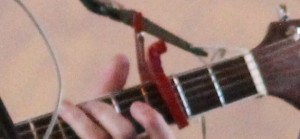
This is a standard 6-string guitar capo.
I love capos.
There was a time where I once thought that a capo was a sign that the musician lacked musical prowess to be able to play these chords outside of a, for lack of a better word, a “crutch.” Most folks resort to capos when they first learn, so to play songs in keys that were too hard on the fingers.
I have now… ahem… changed my tune. (sorry).
There are two reasons.
First and foremost, it is because I have discovered how malleable an instrument a guitar is. This simple setup–six strings, twelve-plus frets, is enough for legendary guitarists to master styles from classical to rockabilly. But even moreso, any “trick” one can use on the guitar doesn’t just affect the ease-of-use on the musician himself, but also can expand the sounds that the guitar can make.
Each time a person strums a guitar, that musical combination of notes creates not just a cohesive sound, but also a tone. That tone, while subtle, sets the whole song apart. In my opinion, it is in crafting the proper tones that should be first in every guitarists’ arsenal. By doing so, he is finding the proper voicing so as to best serve the lyrical content.
Secondly, because of the wealth of partial capos in existence, there is more flexibility than ever before, to craft sounds that befit a proper tone.
This page has links to the types of capos I use. When I craft a songbook, I will focus specifically on full-neck chord page charts, so folks can see the chord progressions I use, incorporating combinations of capos on a single neck.
And, that part about it being easy for a guitarist to use? Still applies.
